How to Take Care of Your Solid Wood Furniture
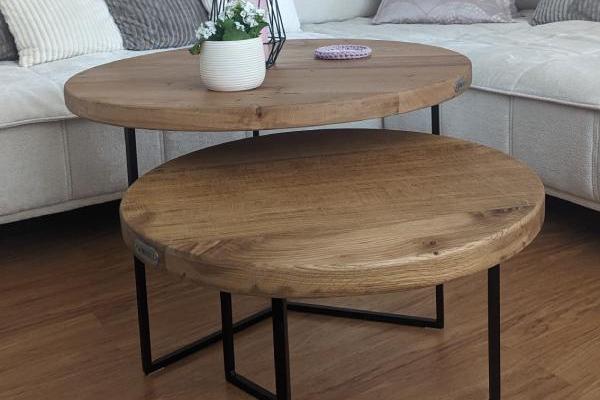
Solid wood is a natural material known for its distinctive grain, pleasant aroma, and unique design. Furniture made from solid wood (and not just solid wood) requires special care. In our carpentry workshop, we craft high-quality and stylish pieces every day, exclusively from the finest solid wood. To ensure that your dining tables, coffee tables, and other furniture pieces remain beautiful and functional for as long as possible, proper care is essential.
Our Care Instructions for You
When we deliver your ordered furniture, we always personally explain how to handle it, what cleaning products to use, and what to avoid. However, we understand that in the excitement of receiving your new designer piece, it can be easy to forget some details. That’s why we’ve put together this guide—to ensure you can always revisit our care instructions when needed. And, of course, we are always happy to hear from you, so feel free to contact us with any questions—even repeatedly.
How to Care for Your Solid Wood Furniture
It’s no secret that to keep your designer industrial-style dining table looking its best for years to come, it needs to be kept clean. However, the challenge lies in knowing the right way to clean it. To make things even trickier, the appropriate cleaning method depends on the type of surface treatment you have chosen.
Beyond cleaning, several other factors influence the longevity of your wooden furniture—factors that you can control. These include exposure to sunlight, indoor humidity levels, and more. Below, we will explore each of these aspects in detail to help you keep your solid wood furniture in perfect condition.
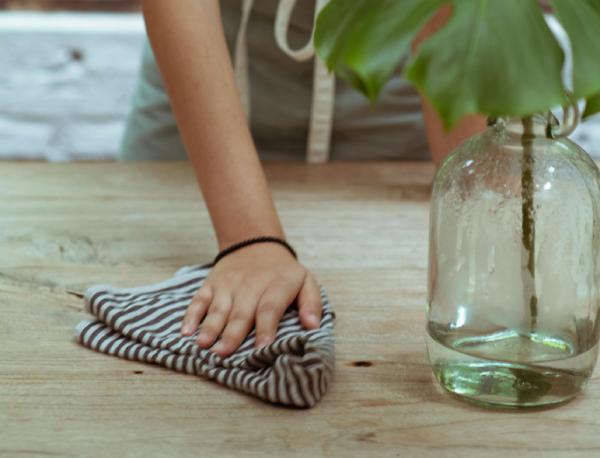 Dusting Your Furniture (Not Just Solid Wood)
Dusting Your Furniture (Not Just Solid Wood)
As mentioned earlier, keeping your furniture clean is essential. If you already clean your home regularly—at least once a week—this step won’t require any extra effort.
We recommend wiping down solid wood furniture at least once a week using a dry, short-fiber cloth. If necessary, you can slightly dampen the cloth, but only minimally. The cloth should never be wet! Wood is a natural material that absorbs moisture, which can lead to damage. Ideally, opt for a dry method to remove settled dust.
If wiping with a cloth doesn’t seem like the best option for you, you can also use a vacuum cleaner. However, always ensure that you use dry suction only. To prevent accidental scratches on your furniture, never use standard vacuum nozzles, brush attachments, or other hard accessories. Instead, use a soft-bristle attachment, which is significantly gentler and designed for this purpose. Avoid pressing down on the nozzle to prevent accidental slipping that could scratch the furniture.
Avoid Water
Water and wood simply don’t mix well. While surface treatments such as varnishing can offer some protection against moisture, prolonged exposure to large amounts of water will inevitably damage the wood. That’s why it’s always best to clean your furniture using a dry method.
If you accidentally spill water on your furniture—such as when watering plants—immediately wipe up all the moisture and allow the furniture to dry completely in a well-ventilated area. Depending on the extent of the spill, this may take several days to ensure the wood is fully dry. However, never place the furniture near a heater or attempt to dry it with a hairdryer, as high temperatures can also negatively affect the wood.
We understand that avoiding contact with water and other liquids is nearly impossible, especially when it comes to a dining table. However, promptly wiping up any spills and keeping the tabletop dry and clean will go a long way in preserving its quality. To prevent damage from cup rings, water stains, or burns from hot cookware, always use cork or other protective coasters.
Beware of Heating and Other Sources of Excessive Heat
Not only solid wood but all types of wood are sensitive to excessive heat and high temperatures. And it’s not just open flames that pose a risk—placing your furniture too close to a radiator, fireplace, or space heater can also lead to significant damage.
The side of the furniture facing the heat source will suffer from temperature fluctuations, which can cause deterioration in just a few weeks! But how do you determine the right distance from a heat source? There is no universal answer. We recommend placing the furniture far enough away so that you don’t feel any noticeable temperature change when you place your hand near it.
Whether it's central heating or a wood-burning stove, the general rule is: the farther, the better. Prolonged exposure to high temperatures can cause excessive drying of the wood and result in discoloration in the affected area. To preserve the longevity and beauty of your furniture, ensure it is kept at a safe distance from heat sources.
Avoid Direct Sunlight
Similar to excessive heat, direct sunlight—specifically UV radiation—can affect the appearance of your solid wood furniture. The good news is that while UV exposure may alter the wood’s color over time, it does not compromise its structural integrity. After several months, you may notice slight changes in the shade of the surface or varnish. To prevent uneven discoloration, try to position your furniture away from direct sunlight.
If avoiding sunlight is not an option, consider placing the furniture so that sunlight reaches the entire surface evenly. This will ensure that any color changes occur uniformly, rather than creating distinct patches. While a slightly altered shade due to sunlight exposure is mostly an aesthetic concern, it's still something to keep in mind when arranging your furniture.
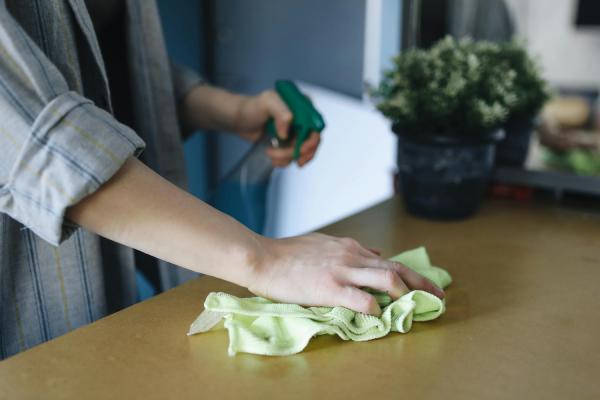 Special Cleaning Products for Wood
Special Cleaning Products for Wood
The market today offers a vast array of specialized cleaning products, which can make it challenging to choose the right one. Always opt for cleaning solutions specifically designed for solid wood and wooden surfaces. If you're uncertain, consult the product seller for professional guidance. Even better, seek advice from the carpenter who crafted your furniture.
It's always safer to use a gentler cleaning product rather than risk damaging your furniture. However, if damage does occur, consult an expert to find the best restoration solution. In some cases, it may be necessary to sand down the surface and reapply a protective finish. If needed, professional restorers or woodworking specialists can help bring your furniture back to its original beauty.
Sharp and Hard Objects
Solid wood is a natural material and is not as resilient as other, more durable materials like iron or steel. Dropping a sharp or hard object on your wooden furniture can cause scratches or unsightly grooves. These types of damage often occur accidentally, when something falls and dents the wood.
Minor scratches and shallow grooves can usually be sanded down, while deeper ones may require filling and refinishing. In such cases, professional carpentry intervention will be necessary to restore the surface and maintain the furniture's original look.
Surface Treatment of Solid Wood
Proper care of solid wood furniture is also influenced by its surface treatment. If you own a designer piece that is untreated, it must never come into contact with water—not even a damp cloth. Water penetrating the wood’s structure can lead to surface cracks, blistering, and other changes in the appearance and shape of the wood.
Treated solid wood is slightly more resistant, but it is still best to avoid water and use only a lightly dampened cloth for cleaning. Do not apply excessive force—avoid scrubbing or rubbing the surface. Instead, gently wipe the wood and allow it to dry completely before placing items such as tablecloths or decorative objects (e.g., vases) on it.
Oil Finish
Solid wood, like all natural materials, breathes and constantly adapts to its environment. It also absorbs dust, dirt, and moisture, which is why proper maintenance is essential. One of the effective surface treatments for wood is oiling. Oil creates a natural protective layer while still allowing the wood to "breathe," as it does not clog its pores.
However, the downside is that oiled furniture requires significantly more maintenance and does not provide the same level of protection against moisture and mechanical damage as lacquered wood. Therefore, especially in the beginning, it is necessary to treat the furniture with oil more frequently—at least twice a month—until a sufficiently strong protective layer forms, offering the wood adequate protection.
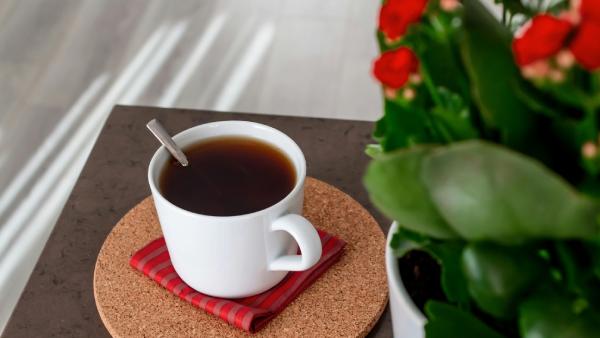 You should strictly follow these guidelines:
You should strictly follow these guidelines:
- Wipe up spilled liquids immediately to prevent them from soaking into the wood structure. Otherwise, the wood may crack or warp.
- Gently wipe the surface without pressing the liquid further into the wood.
- Always wipe in the direction of the wood grain and ensure the surface is thoroughly dried.
- Use only a cotton cloth for wiping.
- Avoid placing heavy, hot, sharp, or damp objects directly on the furniture.
- Always use coasters under damp or hot objects placed on the table.
- Do not use cleaning agents containing acetone, gasoline, or other aggressive substances.
Regular Cleaning
- Dust – Remove it with a dry cloth or a slightly dampened one at least once a week. A dry duster can also be used.
- Dirt – Wipe off with a slightly damp cloth. You can add a small amount of soap or special cleaning products designed for oiled wood surfaces.
- Never use chemical cleaners, detergents, acetone, or gasoline.
Proper maintenance will help extend the lifespan of your furniture. We recommend oiling the surface of your furniture once every 4 to 5 months.
Surface Treatment: Lacquering
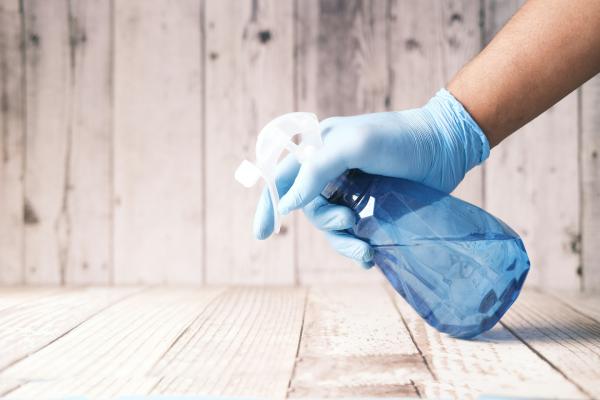 Another highly durable surface treatment is lacquering. Below are the key care guidelines for maintaining lacquered solid wood and wooden furniture.
Another highly durable surface treatment is lacquering. Below are the key care guidelines for maintaining lacquered solid wood and wooden furniture.
- For lacquered wood, use products with antistatic properties to prevent dust buildup.
- Avoid products containing silicone, as they can cause permanent damage to solid wood. Kitchen cleaning agents and various detergents are also unsuitable for cleaning wood or solid wood furniture.
- Do not use 2-in-1 products—if you need to clean the furniture, buy a dedicated cleaning agent; if you need to preserve it, get a wood preservative. Always use a product specifically designed for your intended purpose.
- Never place hot objects (such as pots) directly on a solid wood tabletop. Always use coasters under wet objects (glasses, vases, plates).
- Although lacquer offers a good level of protection, always wipe away any spilled liquids immediately.
- For stain removal, always use a damp cloth. You may add a small amount of a specialized soap cleaner designed for lacquered surfaces.
- After wiping with a damp cloth, always dry the surface thoroughly with a dry cloth to remove any remaining moisture.
- If a standard cleaning agent does not work, you can try a specialized product, but always read the instructions carefully. If using a new product for the first time, test it on an inconspicuous area to ensure it does not damage the surface.
- Never use organic solvents such as gasoline, thinners, or similar substances, as they can dissolve the lacquer.
- Avoid polishes containing oils and abrasive cleaners, as their particles could scratch the lacquer.
- Clean up any spills or stains immediately to increase the chances of removal and reduce the risk of damage to the solid wood.
Surface Treatment: Waxing
Wax finishing is a popular choice, especially due to its eco-friendly properties. However, it is important to remember that waxed wood is not waterproof. To prevent damage and ensure that your furniture remains beautiful for years to come, be sure to follow these guidelines:
- Ensure that waxed wood does not come into contact with water. Immediately wipe away any spilled liquids to prevent damage. Do not leave wet objects on the surface for extended periods.
- Never place hot items directly on waxed wood, as this can damage the wax coating. Always use protective pads under hot pots, wet glasses, and vases.
- Keep waxed furniture away from heat sources, such as stoves or radiators, as high temperatures can cause the wax to melt.
- Proper use of waxed furniture is key to its longevity. Over time, scratches and marks may appear due to natural wear and tear. Whether you see this as a natural part of aging or as an issue that requires repair (sanding and rewaxing) is up to you.
- Always clean waxed furniture with a dry, soft cloth. Regular dusting is essential, as dust particles left for too long can settle into the wax and become difficult to remove.
- Use only cleaning products specifically designed for waxed wood. These products not only clean the surface but also replenish the wax, helping to maintain a protective layer and covering minor scratches.
- Avoid washing with water and using any detergents. Cleaning agents containing bleach can be particularly harmful due to their aggressive chemical properties.
 Conclusion
Conclusion
We hope that after reading our article on how to properly care for your solid wood furniture, you now have a clear understanding of what to do—and what to avoid. In general, you should prevent contact with water, use only cleaning products designed for wood, always place protective pads under objects, handle your furniture with care to avoid mechanical damage, and regularly maintain its surface treatment.
If you have any questions about the above recommendations or are dealing with an issue that wasn’t covered in our article, don’t hesitate to contact us. We’ll be happy to assist and provide guidance.
